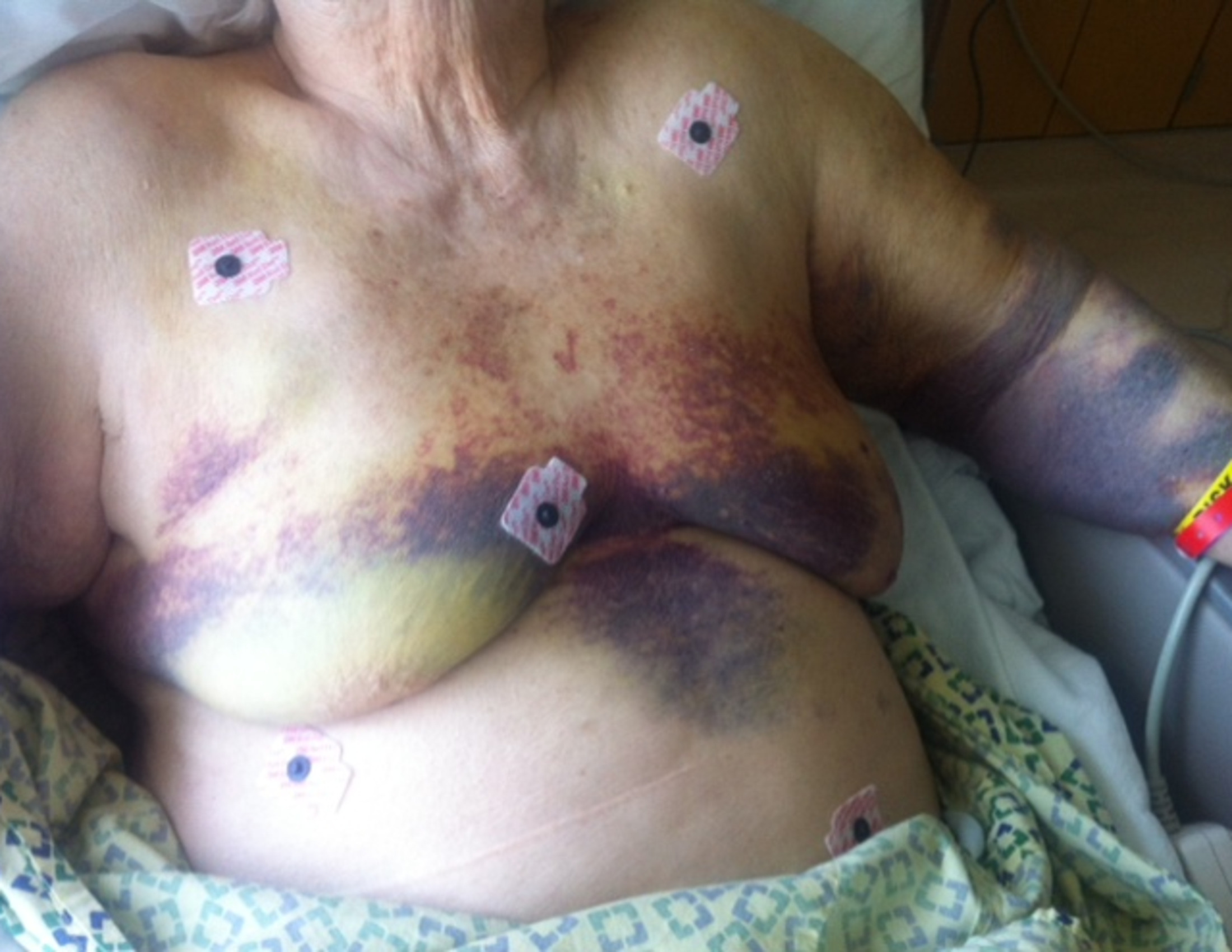Case Presentation: A 88-year-old female presented to an outpatient office with 3 weeks history of severe progressive bruising and ecchymosis which initially developed on left wrist and then spread to bilateral upper extremities, upper trunk and bilateral breast. Patient was recently diagnosed with intraductal adenocarcinoma of right breast (T2,N2,M0, Stage IIB). She declined surgery and tamoxifen (20 mg /day)therapy was initiated 2 months prior her presentation. Patient had a history of myocardial infarction and was taking aspirin for 10 years. She discontinued taking tamoxifen 2 days prior presentation. Physical examination was remarkable for ecchymosis (black and blue) covering most of upper body, upper extremities, bilateral breast and edema of upper extremities. Laboratory investigation showed elevated PT (23.9 sec), INR (2.2), PTT (46.2 sec), D-dimer( >35,200 ng/ml), fibrinogen degradation products(>40 ug/ml) and low fibrinogen(<50 mg/dL),Hemoglobin (7.5 g/dL), Platelets (89 k/uL). Von Willebrands assays, Factor VIII assay and platelet function studies were normal. Aspirin was discontinued and patient was admitted to intensive care unit for disseminated intravascular coagulation (DIC) and received 4 units of cryoprecipitate and 1 unit of red blood cells .CT of chest, abdomen and pelvis showed stable appearance of two nodular densities at 6:00 clock position below the nipple of right breast and axillary lymphadenopathy. After stopping tamoxifen patient’s symptoms were resolved. Repeat laboratory tests after a week revealed normal fibrinogen (206 mg/dL),PT (12.3 sec), INR (1.2), PTT (28.8 sec ), platelets (217 k/uL) and repeat D-dimer after 2 months went down to 12,330 ng/ml.
Discussion: Tamoxifen, a selective estrogen modulator is widely applied for adjuvant therapy for hormone receptor-positive breast cancer. It induces apoptosis in breast cancer cells through caspase-3 and JNK-1 pathways. It’s application is associated with two to fourth increase risk of venous thromboembolism and stroke. The recent study Heiko et al demonstrated development of acquired activated protein C resistance under tamoxifen therapy in breast cancer patients. Also there has been 2 case reports published about tamoxifen associated purpuric vasculitis, with possible explanation of forming antibodies against tamoxifen resulting in circulating immunocomplexes. Another case report described a 88-year-old female who developed generalized ecchymoses and hematoma of right arm after starting treatment with tamoxifen, it was found that her factor VIII assay was 13% of normal and was treated for acquired factor VIII deficiency. Also another case report described a patient with new bruising and prolonged bleeding, investigation concluded platelet storage disease associated with tamoxifen therapy
Conclusions: This case illustrates the potential of development of life-threatening condition during tamoxifen therapy, which was diagnosed in the setting of outpatient office. Also to our knowledge this is a first case report describing DIC associated with tamoxifen therapy.
